Above: photograph by Walter Lee, Grantham Library Collection © Lincolnshire County Council
by John Clayson
This page documents episodes in Grantham's wartime history which, we hope, will give an insight into how the Second World War left its mark on the town, on the railway, and on passengers and staff.
- In 1940 and 1941 German bombers were frequently in the skies above Grantham, seeking out targets among the engineering and armaments factories but causing casualties and damage in homes and on the railway too;
- Wartime posters asked 'Is your journey really necessary?' For the thousands of men and women travelling to and from their essential duties, station announcers and tea bars helped to bring a little cheer to long, slow journeys in blackout conditions;
- During 1944 three Grantham railwaymen lost their lives while on duty doing work which was made especially hazardous by the war;
- In 1941 a clerk left the Stationmaster's office for the RAF to be trained for a vital role in wartime communications;
- Finally, we look at the wartime career of a young Grantham railwayman whose service in the Royal Navy earned him the Distinguished Service Medal and a Mention in Despatches.
1. Air Raids, 1940-41
Between September 1940 and October 1942 Grantham received regular attention from the Luftwaffe. The town occupied a strategic location on the East Coast Main Line and the Great North Road, and it was also home to the British Manufacture and Research Company (BMARCo) works on Springfield Road, near one of the locomotive sheds. Known locally as 'Marco's', the factory made 20mm cannon for the RAF's Hurricane and Spitfire fighters.

From the collection of Coloptics.com
Air Raid on Wednesday 23rd October 1940
The railway first suffered serious damage when, at about 4pm, a bomb fell on Spittlegate Bridge, which carries the Great North Road over the main line into Grantham from the south. Beneath the tarmac were pipes bringing Grantham’s principal supply of water from the works at Saltersford. Fortunately most of the bridge remained intact, so traffic on both rail and road was soon restored to near-normal.

Map by Walter Lee, Grantham Library Collection © Lincolnshire County Council [LCL8207 001]
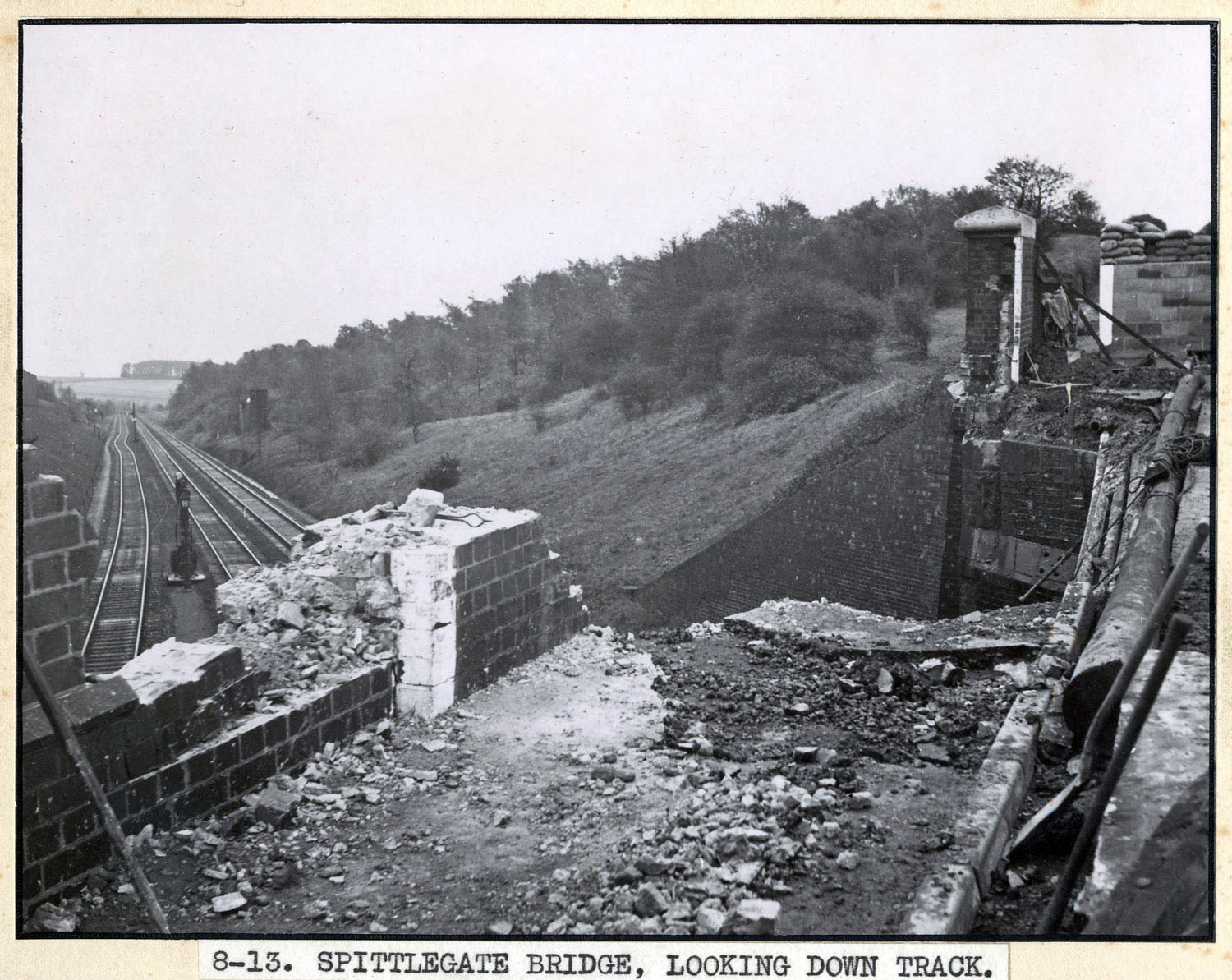
Photograph by Walter Lee, Grantham Library Collection © Lincolnshire County Council

Photograph by Walter Lee, Grantham Library Collection © Lincolnshire County Council

Photograph by Walter Lee, Grantham Library Collection © Lincolnshire County Council
Walter Lee witnessed the scene and took the photographs above on the following morning, Thursday 24th October. Below is an extract from Walter's written account of the scene. He first described how the main lines appeared still to be obstructed with debris and then:
The single line [i.e. Up Goods Line] arch was almost untouched and it was through this that trains were passing. As a matter of fact at the time of the incident the "Flying Scotsman" [i.e. the train service] had just come to rest in the station and it was along this line that it was able later to make its way south, two hours late.
Air Raid on Tuesday 3rd December 1940
Soon after 3pm an enemy aircraft was engaged by the BMARCo factory defence guns, manned by works staff on Home Guard duty. The plane was hit, damaged and driven off, but not before it had released four bombs on the town. One of the bombs landed on sidings between the station and Springfield Road bridge, but it did not detonate. Bomb disposal experts were sent for.

Map by Walter Lee, Grantham Library Collection © Lincolnshire County Council

Photograph by Walter Lee, Grantham Library Collection © Lincolnshire County Council
The following day, bomb disposal team excavations exposed a 1,000lb bomb. The officer, Lt. John Ernest Gilkes of Leamington Spa, reported that the bomb was fitted with two detonators, each equipped with a booby trap device. Its time fuse could be heard ticking. If not stopped it was likely go off sometime during the following 10 days. At 3.15pm the area was cleared so that Gilkes could attempt to make the bomb safe to remove. Three minutes later a terrific explosion rocked the station area, blasting two policemen who were approaching to check on progress. The courageous Lieutenant died instantly.
Inspector Curry, one of the policemen, wrote in his report of the incident,
I have nothing but admiration for the dauntless courage of this officer [Lt. Gilkes]. I am convinced that he knew he was taking a risk which was almost certain to cause his death. He took that risk cheerfully, however. One of his last remarks to me before I left him was, “Well, when you come back I shall most probably be on my way to St Peter.”

© Royal Engineers Association, Bomb Disposal Branch
Coventry to Grantham in Spring 1941: Frying Pan to Fire?
Here is Graham Whitehead’s story about arriving in Grantham from Coventry, supposedly as a break from the city’s devastating bombardment - only to arrive in the middle of a daylight raid!
My grandmother, who lived with my grandfather on the other side of Coventry, had a sister who lived in their birthplace of Grantham. It was decided, after one of the heavy bombardments of Coventry, (I imagine it was after the raids of April 8 and 10 in 1941) that my mother would take my brother and me to stay with mother’s aunt Lydia (Mrs Dawson) who lived at 13 Rutland Street Grantham, for a brief interlude from enemy bombardment.
We had no car at that time and the journey was made by bus, changing at Leicester and travelling through Melton Mowbray. On arrival in Grantham my brother Brian aged 8, carrying the suitcase, and my mother with me in a push-chair (folding baby buggy, for those who do not know what a push chair was) alighted from the bus to witness a daylight raid by a German fighter plane which was firing at a stationary train waiting on the viaduct for a signal to enter Grantham station. This railway viaduct (a bridge over Harlaxton Road, some five minutes’ walk from Rutland Street) afforded temporary shelter from the incident on the bridge overhead.
Although I was too young to have any memory of this, my brother Brian (now living in Australia) recalls the raid vividly. Apparently the speed with which Brian carried the suitcase, and my mother pushed me in the push-chair, was unprecedented! On arrival at 13 Rutland Street (now, alas, demolished for a bus station) my great-aunt , sheltering from the raid in the cellar of her home, ignored the frantic knocking at the front door thinking it was the fall of shrapnel. Presumably the persistence of knocking, or the ‘all-clear’, alerted aunt Lydia to open the door and accept into her arms the waifs and strays from bomb-ravaged Coventry.
© Graham Whitehead, WW2 People's War
WW2 People's War is an online archive of wartime memories contributed by members of the public and gathered by the BBC. The complete archive can be found at www.bbc.co.uk/ww2peopleswar

Photograph taken by Ted Burton.
2. Good Cheer for Travellers
Here are news items about efforts to keep travellers’ spirits up during long wartime journeys.
The Girl Announcer at Grantham
The ‘hello girl’ is no longer exclusively claimed by the telephone exchange. She greets us on the railway platforms of wartime Britain, and a heart-warming welcome it often is. I walked on to the platform at Grantham on a depressing night recently, and was hailed by the loudspeakers with a cheery "Hullo, passengers!" It was a friendly hello, and I felt better for it.
This certainly seems to be one wartime job in which women are showing peculiarly apt qualities. Some of those masculine announcements from the railway loudspeaker in peacetime had a husky, fog-horn pitch which did not always get across. But there is far more in this than mere clarity. My announcer of Grantham railway platform might so easily have lapsed into a deadening monotone through constant repetition. Instead, a welcoming smile shone through her words.
From The Yorkshire Post, Saturday 19th December 1942

From The British Newspaper Archive
Image © THE BRITISH LIBRARY BOARD. ALL RIGHTS RESERVED.
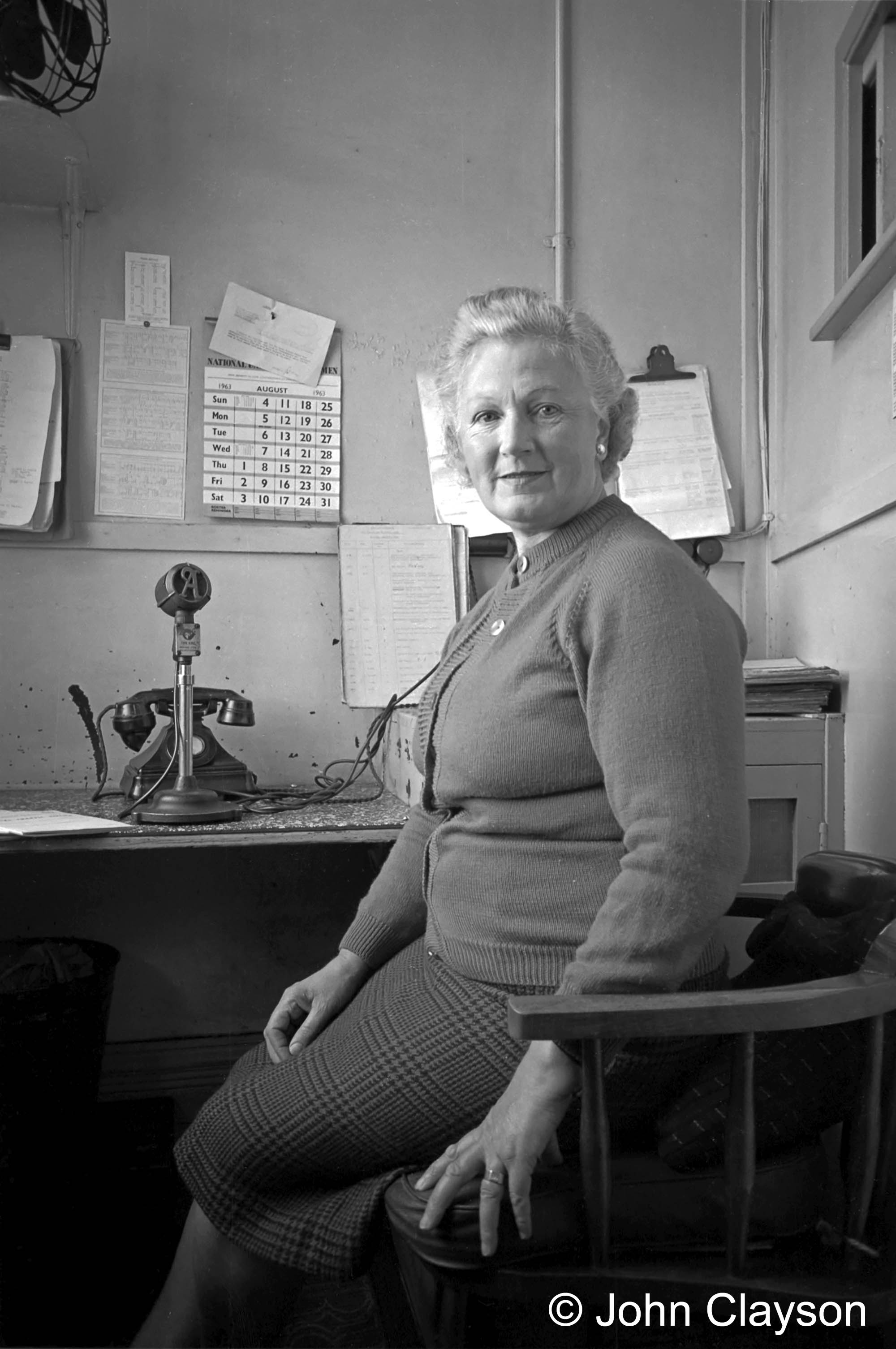
Photograph by Cedric A. Clayson.
Irene Clarke, ticket collector
Irene began working at Grantham station in 1944 after her fiancé, Derrick Bradford, was called up. During her time there she worked both as a porter and a ticket collector, sometimes travelling on the trains. She was once put on the train with a fur coat to be delivered to a hotel in London, a titled lady having left it behind.
Yvonne Parker, Irene's daughter, sent the following photograph, taken on platform 2 (today's platform 1).

Yvonne says, "Two of the people in it are known to me. Ernie Huckerby on the left and my mother Irene Bradford (née Clarke) on the right. I think this picture was taken just before she left, which was in the summer of 1947 having been married the previous January. In the late 1960s she returned to work in the Refreshment Rooms and was taught how to make a British Rail sandwich!
"I would really like to know who the other two people in the picture are too. I do have some information regarding the other lady which may be of help. She was not local, I think Mother said she came from Gainsborough, was married to another station employee and moved away from Grantham not long after the picture was taken."
Note: We now know that the gentleman standing between the two ladies is Joe Darmon, the Up Side Station Inspector. Joseph Darmon was born at Great Gonerby in August 1884. During the 1890s he lived with his family at Barkston, his father being a railway platelayer. Leaving home around 1900, Joe began working in Leeds as a railway telegraph lad (a trainee signalman). He had several posts as a signalman at locations in Yorkshire and Nottinghamshire until, by 1911, he was back near his parents, living and working at Hougham. Towards the end of 1936 Joe Darmon was promoted from Relief Signalman at Grantham to Station Inspector. We don’t know when Joe retired, but if he continued to work until the age of 65 it would have been in the summer of 1949. He was clearly still working at Grantham station in 1947 when the photograph was taken.
Tea Bars for Grantham Station
To extend light refreshment facilities on station platforms and lessen congestion in refreshment rooms, the L.N.E.R. is providing tea bars at some of its main line stations. Grantham will have these soon on both platforms.
They have been designed and equipped for rapid service and will sell cups of tea, various kinds of sandwiches, meat pies, cakes and pastries and cigarettes.
Of standard unit design to ensure rapid erection on site and minimum interference with traffic working, the tea bars consist mainly of light framing, clad externally with corrugated asbestos sheeting and internally with glazed asbestos sheeting. The latter material has also been used for the shelves and open counter top.
From The Grantham Journal 28th January 1944, page 2

From The LNER Magazine, September 1944 page 174, with acknowledgement to the LNER as publisher and with kind permission from the Great Eastern Railway Society.
3. The Home Front: three Grantham railwaymen who died on duty in 1944
Railway service, hazardous in normal conditions, could be even more deadly during wartime. The following three men died in the course of their duty, doing their utmost to keep the traffic moving at night during the blackout and with maintenance reduced to the bare essentials.
John Bone, 24th January 1944
John Bone, aged 58, lived at 11 Front Villas, Dysart Road. He was a shunt-horse driver in the goods yard. Shunt horses were strong, sturdy animals used to move one or two wagons at a time in sidings. The horse walked alongside the track, its harness attached by a tail chain to a hook on the side of the wagon being moved. Shunt horses continued to be employed at Grantham for several years after the war.
On the night of Monday 24th January 1944 John attached his horse to two wagons, which they began to pull. They were moving away from the goods shed towards other wagons standing in the No. 1 siding. Suddenly, with a deafening roar, the safety valve of a nearby locomotive lifted. The horse, said to be a quiet animal normally , was startled by the noise and it bolted. Unable to take avoiding action in time, John was caught by the tail chain which threw him into the gap between the two sets of wagons as they came together. He was caught between the wagons’ buffers, and on 2nd February he died as a result of his injuries.
Harry Shardlow, 3rd February 1944
On Thursday 3rd February, the day after John Bone passed away, fireman Harry Shardlow, a near-neighbour of John’s at 27 Front Villas, left Grantham with driver Horace Healey on the footplate of a southbound Scotch express.
It was recognised at the outset of the war that the glare from the open firebox door of a steam locomotive at night made the railway vulnerable to attack from the air. Anti-glare sheets made of canvas were fitted to locomotives. During daylight they were rolled forward and tied to the rear of the cab roof. As night fell it was the fireman’s duty, on the move if necessary, to unroll the blackout sheet and fix it to the front of the tender.

From The British Newspaper Archive
Image © THE BRITISH LIBRARY BOARD. ALL RIGHTS RESERVED.
As the Scotch express sped south into the dusk near Woolmer Green, in Hertfordshire, Horace was peering forward to get a sight of the distant signal for Welwyn North. At this point he believed that Harry must have climbed into the tender to begin to fix the blackout sheet. Harry either misjudged the height to which he’d climbed, or he mistook exactly where the train was. Just south of Woolmer Green there were two bridges over the line, both with minimal clearance above a locomotive’s cab – just 4 or 5 inches. Poor Harry died instantly when his head hit one of the bridges.
Horace glanced back into the cab to see Harry lying across the footplate, grievously injured. We can only imagine the desperate scene as the driver stayed at the controls to bring the train safely to a stand at Welwyn North station before he could do anything to try to help his mate.

Harry was 36 and he left a widow and a daughter, Ann, just nine weeks old. As one of Grantham Loco’s most senior firemen Harry would surely soon have been promoted to driver. He was well known in the town. A regular player with the Grantham Loco football team, he’d had trials with Grantham Town and Mansfield football clubs and he served in the railway Home Guard.
Percy Amos Meade, 31st May 1944
It was around 3 in the morning at Grantham Loco. Fireman Arthur Freeman was filling the tender tank of class A3 locomotive No.2581 Neil Gow near the coaling plant. Running foreman Sidney Ingleton and the locomotive’s driver, Percy Meade, were standing together nearby. Percy was 44 years old and had grown up at Winthorpe, near Newark. He lived at 118 Alexandra Road in Grantham with his wife Harriet and their daughter Marjorie.
Suddenly Percy shouted ‘Whoa!’ as he saw the engine begin to run away on its own. He made for the left side of the engine as it approached the coaling plant, grasping the handrail as if to climb into the cab. Meanwhile Sid ran round the rear of the tender, entered the cab from the right side and brought the locomotive to a stand further down the yard.
Tragically, Percy slipped while trying to climb aboard. He became trapped as his side of the engine approached a platform alongside the coaling plant. Arthur and Sid found him below the platform, crushed to death.
It was discovered that there were two faults with the locomotive, the effects of which had combined to cause it to move off out of control. First, there was a crack in a reservoir in the braking system which would have caused the brake to ‘leak off’ gradually during the time it was standing. At the same time, a leaking regulator (the driver's main steam valve) allowed a build-up of steam pressure in the cylinders. This had eventually been sufficient to overcome the weakening brake and put the engine into motion. The tender handbrake should have been put on by the crew while the engine was standing unattended and would probably have held it back, but it hadn’t been applied.
No. 2581 had last received an overhaul at Doncaster Works 18 months before the accident. In circumstances other than wartime it would very likely have received repairs to put right the leaking brake before it became serious enough to cause the accident.

With thanks to Mike Morant.

The photograph was taken by Colin Walker on Grantham shed's last day in operation, Saturday 7th September 1963.

4. Sergeant Sydney Harmston, RAF
(from notes kindly supplied by his son-in-law, Tony Gostick)
Railway Service, 1921-41
Sydney was born at Eastwood, Nottinghamshire in 1906 but by the time he was four years old the family had moved to Grantham where his father, Richard, became a railway Ticket Collector and later a Guard.
Mr. Harmston comes off a railway family so that, he says, it was almost inevitable that he should join the service, which he did after leaving Grantham King's school at the age of 15 in 1921.
He started as a junior clerk in the goods department under the late Mr. C. J. Cooke at a salary of £35 a year, which rose to £80 a year when he was 18.
He then accepted a position in the goods department at Doncaster and was there during the General Strike of 1926. In February, 1927, he returned to Grantham, haying accepted a post in the stationmaster's office under Mr. Dennick.
(from The Grantham Journal, Friday 28th May 1971)
In his 20s Syd Harmston studied to gain qualifications in Railway Operating (1929) and Railway Geography (1930) from the University College of Nottingham, an institution which was expanding into spacious new buildings that became the present-day University Park campus.


In April 1938 Mr Cooke, who was head of the goods department when Syd Harmston joined in 1921, retired as Grantham Station Master. He was photographed with his staff, including Syd (middle row, third from the left).
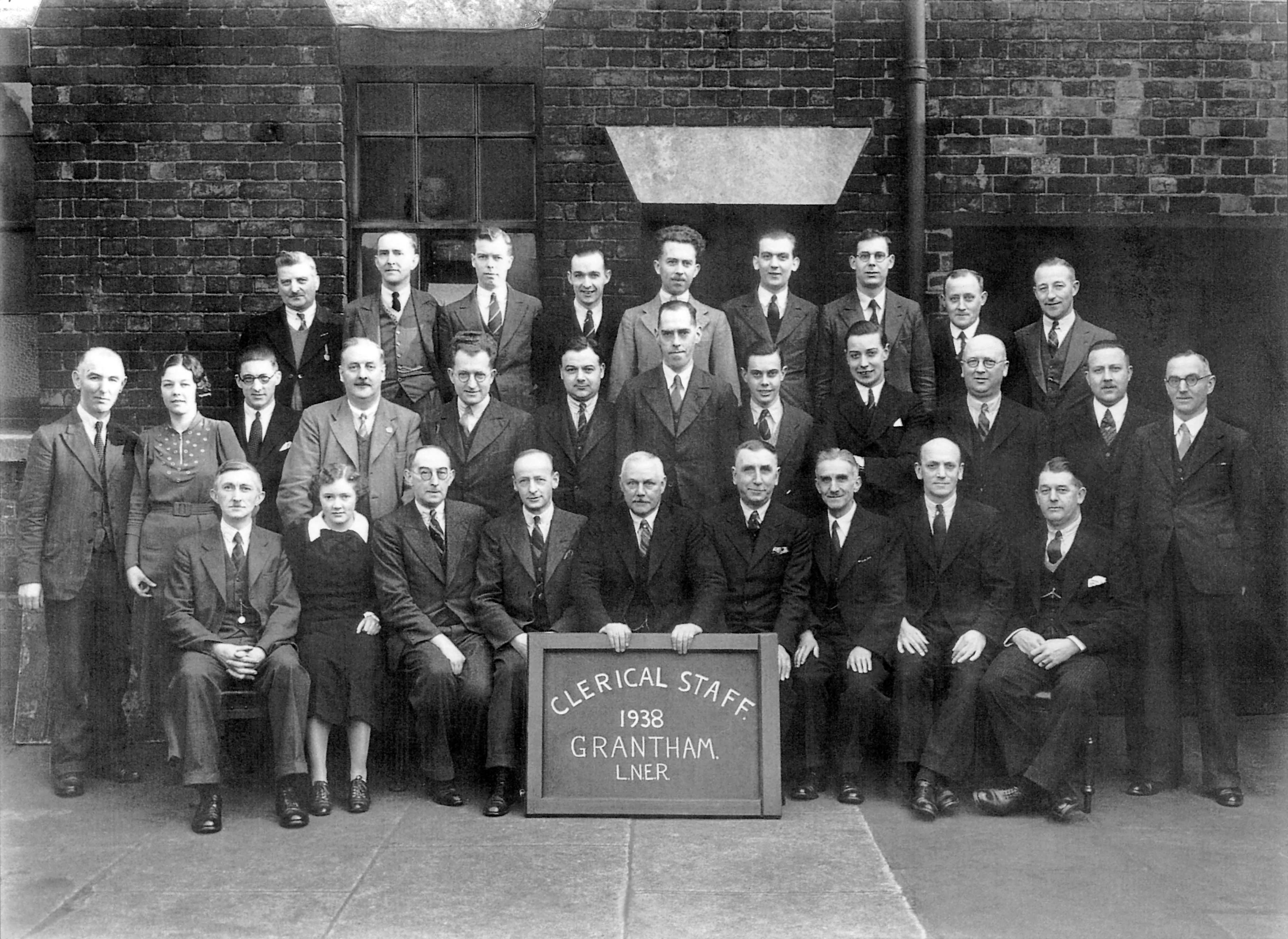
Back row: R.M. Bennett [no relation to the lender], G. Dobney, R. King, R. Pinner, W. Lucock, A.W. Wood, S. Thompson, R.P. Holloway, H.Read. (9)
Middle row: A. Scrimshire (Chief Clerk in the Station Master's office), Miss J. Ebb, S. Harmston, C. Hill, W.H. Barsby, A. Palmer, D. Melrose, J. Tear, C. Johnson, W.L. Selby, H. Holloway, W. Smith (12)
Front row: W.J. Alder (Clerk), Miss Gwendoline A. Worsdale, H. Cheffings, L. Hutchinson, C.J. Cooke (Station Master and Goods Agent), G. Searle, Fred Steer (Townsman, Goods Dept.), A.E. Wilsher, A. Collins. (9)
Note the face peering through the window!
Lent by Boris Bennett.
The next important date in his life was June 10th, 1933, when he married Miss Constance Muriel Tindall, of 49, Huntingtower-road—they have a married daughter, Mrs. Kathleen Gostick, who is living with her R.A.F. husband in Kinloss, Scotland—and the next notable occasion was September 4th, 1941, when he was called up for service in the R.A.F.
(from The Grantham Journal, Friday 28th May 1971)
However, before he left the railway for the RAF Syd was involved in a tragic wartime incident at the station which has already described in detail above. His part in it is summarised here.
Wednesday 4th December 1940
An army bomb disposal team exposed a 1,000lb bomb beneath sidings south of the station. At around 3pm Sydney Harmston took a cup of tea to the officer, Lt. John Ernest Gilkes, as the area was cleared so that Gilkes could attempt to make the bomb safe to remove. Soon afterwards a terrific explosion rocked the station area, and the courageous Lieutenant died instantly.
In the Royal Air Force, 1941-45
Thursday 4th September 1941 - called up for service in the R.A.F., pausing his career on the railway for a little over four years.
He served in Egypt, Italy, Yugoslavia and Malta and was demobilised with the rank of sergeant in December. 1945.
(from The Grantham Journal, Friday 28th May 1971)
In the UK
- 10th September 1941 – to Blackpool for basic training, including square-bashing on the sea front
- 24th October 1941 – to Ayr for training for the Service (RAF) Police
- 7th December 1941 – to Leighton Buzzard for training as clerk Special Duties, RAF Bentley Priory, headquarters of Fighter Command and the office of Air Chief Marshal Sir Hugh Dowding.
- 23rd January 1942 – to RAF Woodvale, near Formby, Lancs, a newly established all-weather night fighter airfield for the defence of Merseyside.
- 4th August 1943 – to RAF Cardington, near Bedford, for a junior N.C.O. course
- 15th September 1943 – to No.5 Radio School. Oxford, which specialised in Code and Cypher training for classified military signals
- 12th October 1943 – passed out as Sergeant
- 14th October 1943 – to RAF White Waltham in Berkshire, headquarters of the Air Transport Auxiliary
- 5th December 1943 – to Morecambe in preparation for overseas draft
To Egypt
- 12th December - left from Glasgow by sea
- 1st January 1944 - arrived at Port Said, Egypt
- 7th February to 4th March 1944 - Refresher Course at RAF Middle East School, Heliopolis, near Cairo
- 28th March 1944 – to the RAF Telecommunications Centre, Heliopolis
(for an insight into the experience of another 'Code and Cypher' RAF Sergeant making a wartime sea passage from the Clyde to Cairo about a year earlier, and the work being done at RAF Telecommunications Centre, Heliopolis, see BBC - WW2 People's War - Life as an RAF Codebreaker).
To Italy
- 12th July 1944 – taken by plane from Cairo to Bari, on the Adriatic coast of Italy
- 18th July 1944 - to HQ Desert Air Force, Naples
- 23rd December 1944 - to HQ Balkan Air Force, Bari
- 1st January 1945 – to 352Y Squadron, a Yugoslav Partisan-manned fighter-bomber squadron of the RAF

To Yugoslavia
- 19th March 1945 – to RAF station Vis, Yugoslavia, partisan leader Tito’s HQ
- 8th May 1945 – the end of the war in Europe
Back to Italy
- 19th to 25th May 1945 - Vis to Ancona and Brindisi by sea and road
- 2nd June 1945 – Brindisi to Bari by road, HQ Balkan Air Force
To Malta
- 17th July 1945 – to Air Headquarters (AHQ) Malta (Bari to RAF Luqa by air)
- 18th July 1945 – to RAF Siggiewi, Malta
Home via France
- November 1945 – By sea to Toulon, France; across France to Dieppe; by sea to Newhaven; by train via London to RAF Hednesford
- Demobbed Friday 12th December 1945
In recognition of his wartime work in support of the Balkan Air Force, Syd attended an annual reception at the Yugoslav Embassy in London for the rest of his life.
Back to Grantham Station
Syd started again on the railway where he left off, in the Stationmaster’s office at Grantham, on 31st December 1945.
It was then back to his old job in the stationmaster's office, where he remained until his final period of leave which leads to his official retiring date, June 5th.
One of the last changes Mr. Harmston saw on the railways happened in 1968, when stationmasters became station managers.
(from The Grantham Journal, Friday 28th May 1971)
Retirement, June 1971
Sydney Harmston's retirement in 1971 after 50 years' railway service was front page news in The Grantham Journal of 28th May.
Syd. retiring after 50 years a railman
ALTHOUGH, for a variety of reasons, the railways have considerably diminished in size and scope in recent years, Mr. Sydney Harmston (65), of 51, Huntingtower road, Grantham, who has just finished 50 years with the old G.N.R., L.N.E.R. and British Rail, thinks there are still plenty of career prospects in the service.
On Wednesday night, at the British Rail Staff Association Social Club, Mr. Harmston was presented with retiring gifts of suitcases and a pipe by Mr. L. Greenwell, British Rail area manager, and Mrs. Harmston received a bouquet from Mrs. Greenwell.
The gifts were subscribed to by the whole of the Grantham station office and outside staff.
(from The Grantham Journal, Friday 28th May 1971)

Left to right: Sydney and Constance Harmston, ?Herbert Holloway, (TSSA), Mrs Greenwell, ?Mr L. Greenwell (BR Area Manager), ?Richard Thompson (TSSA).
To make it a really memorable occasion, Mr. Harmston, who until recently was chairman of the Grantham branch of the Transport Salaried Staffs Association, was presented, on behalf of members, with a cheque by the branch secretary, Mr. Richard Thompson.

5. Able Seaman Jack Ashford, DSM (1919-1983)
Finally, here is the story of a young Grantham man who left his job as a railway porter and carriage cleaner to serve King and Country in the Royal Navy. Cyril John (Jack) Ashford lived with his parents at 16 Albert Street. He started as a messenger boy on the railway aged 15 and later became a porter and carriage cleaner. At that time no one could have predicted that, at the age of 21, his conduct on active service would make the front pages of national newspapers and lead to the award of a medal by the King.
Jack joined the Royal Navy when he was called up after the outbreak of war. By the summer of 1940 he found himself leading the gunnery team aboard HMT (His Majesty’s Trawler) Arctic Trapper. The former Grimsby steam-powered trawler had been converted into an Armed Patrol Vessel in May 1940 to assist with the defence of coast and ports. HMT Arctic Trapper carried a single 12-pounder naval gun.
The exploit which made the news was revealed to the British public in a press release issued by the Admiralty and reported in The People, The Times and, no doubt, other national papers.

© Trinity Mirror
The action is believed to have taken place off Ramsgate, Kent. Though only the captain’s name was mentioned in the Admiralty communiqué, news soon reached Grantham that a young man from the town had distinguished himself in the service of the country. Grantham Gunner Helps In Fine Teamwork was the headline of a column in The Grantham Journal on 30th August 1940. When gunner Ashford was asked for the recipe for shooting down Nazi planes he said, “You want to get the first shot in: they must be in range, of course.”


From the Imperial War Museum collection
Within a few weeks Grantham Rotary Club had adopted the Arctic Trapper, putting out an appeal for gifts to send to the crew.
On 12th November 1940 it was announced in The London Gazette that Jack Ashford had been awarded the Distinguished Service Medal (DSM) ‘for good services when attacked by enemy aircraft’. He was presented with the award at Buckingham Palace in the spring of 1941, and when home on leave in April he was the luncheon guest of the Rotary Club.
Jack’s naval career continued. In November 1942 his name appeared in The London Gazette for a second time when, as a member of the crew of HMS Starwort, a Flower Class corvette (U-boat patrol vessel), he was one of several men who received a Mention in Despatches
…for distinguished services in H.M. Ships Achates, Honeysuckle, Hyderabad, and Starwort in taking a Convoy to North Russia through the dangers of ice and heavy seas and in the face of relentless attacks by Enemy U-boats, aircraft and surface forces.

From the Imperial War Museum collection
Jack Ashford returned to work on the railway after the war, working at Highdyke Yard as, we believe, Yard Foreman or Inspector. We've met number of people who remember Jack, but no-one who can recall being aware of his wartime career in the Royal Navy.
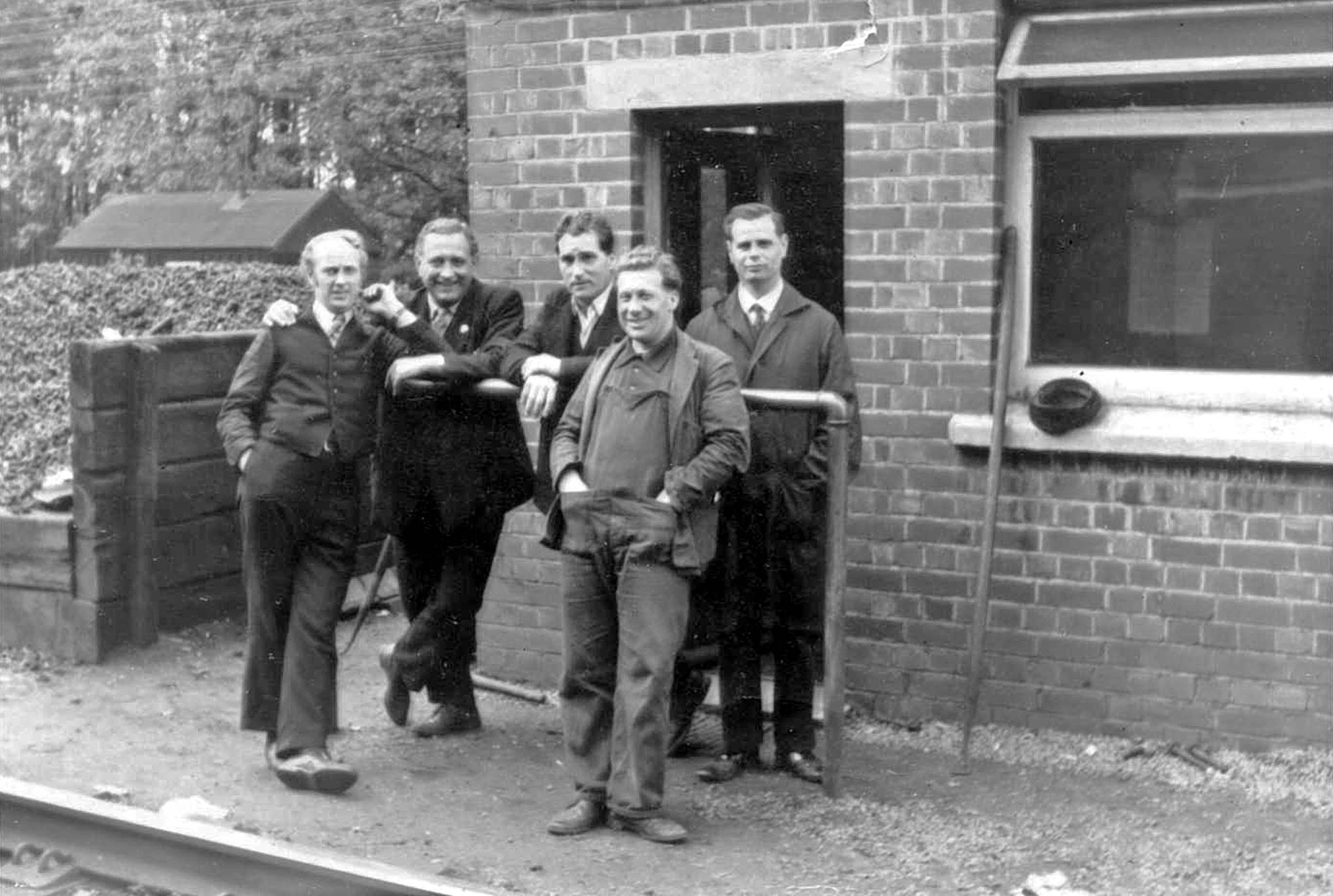
Left to Right: Don Barrett, shunter; Jack Ashford, inspector; Chic Chambers, guard; Harold Hines, C&W examiner; Les Lord, inspector.
Photograph lent by Grahame Wareham
However, Jack made the pages of The Grantham Journal again in the 1950s when his sucess in the sport of angling was occasionally reported, most notably in October 1958:
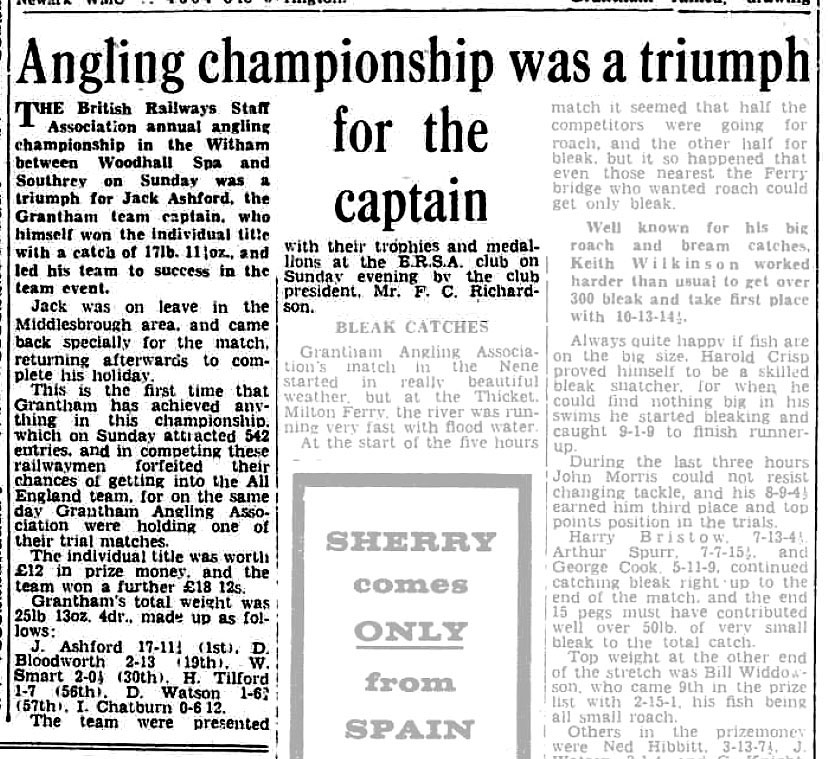
From The British Newspaper Archive
Image © THE BRITISH LIBRARY BOARD. ALL RIGHTS RESERVED.
There is a short item contributed to The People's War website by Mr Clifford Buttery here.
Back to Incidents on the Railway at Grantham


How interesting to read of the various people in the railway employment and history of Grantham. Funny how people who did such a lot of good action at work did not see themselves as something special! Thanks due to the people who researched the details for the article.